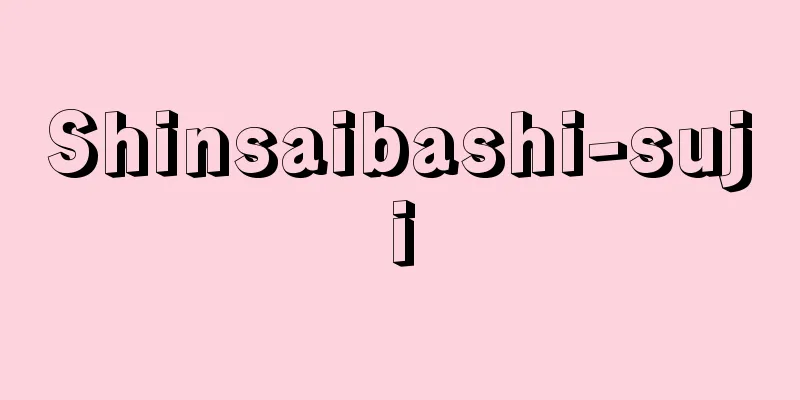Guardian - Shugo

|
In medieval Japan, a warrior or organization that was placed in each province to oversee military administration. They were called shugonin (provincial government office) or shugo (military governor) or shiki (military governor), which means they protected the province. [Akio Yoshie] Source of ProtectionSince the Edo period, the establishment of the Shugo has been considered to have occurred during the early days of the Kamakura Shogunate, but in recent years, as the structure and history of the military systems of various provinces during the Heian period have been clarified, it has become increasingly clear that the seeds of this system were already emerging at the end of the Heian period. In other words, against the backdrop of the situation at the end of the Heian period, when powerful samurai in various provinces began to organize small and medium-sized samurai within their own provinces as their retainers through their status as zaichokanjin, after the Hogen and Heiji Rebellions in the mid-12th century, the Imperial Court and various provinces began to frequently request the mobilization of military forces within their own provinces. Among the kokushu, appropriate ones were given the title of kuni shugonin, and the place where they were stationed within the kokuga was called a shugosho. With the samurai who had become retainers and family members at their core, some began to have the power to mobilize domestic samurai and to protect the kokuga and the provinces. Therefore, it is thought that shugon during this period were appointed arbitrarily at the discretion of the kokushu in accordance with the conditions of the country, and were not a uniform national system; whether they were established or not and the content of their authority varied widely. [Akio Yoshie] The Kamakura Shogunate's Shugo SystemThe Kamakura Shogunate's Shugo were established as a uniform national system based on the above historical premise, incorporating Shugo from the Kokuga as necessary, and newly assigning the main Gokenin of Minamoto no Yoritomo for the rest. In other words, immediately after raising his army in 1180 (Jisho 4), Yoritomo began granting and appointing Shugo in the eastern provinces in his capacity as a head of the samurai family, separate from the traditional Kokushi, and by 1184 (Genryaku 1), when he advanced into the western provinces with the imperial sanction to pursue the Taira clan, he had obtained the consent of the Imperial Court and, under the name of Sotsuibushi (General Pursuing Officer) on the pretext of pursuing the Taira clan, he granted and appointed Shugo in one province after another. In November 1185 (Bun'ji 1), after the fall of the Taira clan, Hojo Tokimasa, who had gone to Kyoto to pursue and capture Minamoto no Yoshitsune, was sent to negotiate with Emperor Go-Shirakawa as his representative, and as part of the so-called Bunji imperial charter, he had the shogunate approve the establishment of shugo (general pursuers) in each province as a nationwide system recognized by the Imperial Court, in addition to jito (land stewards) and hyorōmai (military provisions). The contents of this so-called Bunji Shugo Imperial Charter, along with the Jito Imperial Charter, have a long history of debate since ancient times. There are conflicting theories on whether to see it as a permanent system or a limited time period until the pursuit of Yoshitsune, whether they were called Shugo from the time or whether they were called Sotsuihoushi at the time and only got the name Shugo after the pursuit of Yoshitsune, whether the duties that would later be called the Daibon Sankajo were established at this time or a little later, and what was the relationship of authority between them and the Jito and Hyoryo rice collections, which were also granted by Imperial Charter, and so on. However, despite these conflicting points, it is now accepted as an indisputable historical fact that, at the very least, the Bunji Imperial Charter made Shugo a national system, and that the shogunate established a system of supplementing each province and mobilizing domestic samurai as Gokenin (vassals of retainers) for military service. In addition, as mentioned above, the relationship between the designations of Shugo and Sotsuihoshi has recently come to be understood as having coexisted from the beginning, with the former being considered as a designation given to the Imperial Court and the latter as a de facto designation, and as for whether or not it was permanent, it is now thought that while the Imperial Court only considered it to be until the pursuit of Yoshitsune, the shogunate itself made arrangements to make it permanent. Thus, with the completion of the Oshu Conquest, which included the pursuit of Yoshitsune, in 1189 (Bun'ei 5), a feud arose between the Imperial Court and the Shogunate over the existence of the Shugo.However, with the arrival of Yoritomo in Kyoto, who insisted on the existence of the position based on a fait accompli, the position was established as a permanent institution, and thereafter the duties of the Shugo were rapidly reorganized into a form appropriate for peacetime protection, and the vassals within the country (mainly the Jito) were mobilized to take on the specific tasks of the three major crimes, namely the Kyoto Dairi (Dairi) and Daidairi (Obankyaku) guard duties, and the arrest of traitors and murderers. [Akio Yoshie] The development of protectionFrom the above perspective, the Kamakura Shogunate's Shugo were military administrators who embodied the will of the Kamakura Shogunate as a public authority that controlled the field of military prosecution at the level of each province, and therefore other general administrative duties were still handled by kokushi appointed by the Imperial Court, and even within the field of prosecution, minor issues other than the Three Major Crimes were handled by the Kebiishi of the Kokuga and Shoen (manors), and in general, the intervention of Shugo in these fields was prohibited not only by the Imperial Court but also by the Shogunate, and in order to restrict the direction of intervention, care was taken to prevent the fixation and hereditary succession of kankoku as much as possible and to allow frequent changes. However, on the other hand, the powerful samurai who became Shugo themselves consistently showed a tendency to use the Three Major Crimes as a lever to actively organize minor prosecution and general administrative fields as well, and to follow the path of hereditary succession as much as possible. The Hojo clan's monopoly on provincial shugo positions at the end of the Kamakura period was a counterattack and response to this movement, but it actually stimulated the shugo to become more independent thereafter. In the Nanboku-cho period, the shogunate first granted the shugo the right to carry out lawless practices and to follow the orders of envoys, and took over some of the powers of collection and jurisdiction over the land. It also granted them the right to freely dispose of their territories, which gradually became 'Kessho' (imperial territories), the right to request shugo (shugo-uke), which meant gaining effective control over the land in exchange for collecting a fixed amount of tax, and the right to receive half of the land's tax. With the absorption of the functions of the kokuga (provincial government offices), which had fallen into decline during this time, the shugo paved the way for the establishment of extensive administrative powers, including the right to collect taxes and jurisdiction over the land. As a result, the shugo gradually came to be called shugo daimyo, and went beyond the framework of being officials of the shogunate. Eventually, as the structure of local communities changed, the shugo daimyo evolved and were dissolved into Sengoku daimyo, who powerfully organized small and medium-sized samurai who banded together in rebellions. The reason these Sengoku daimyo competed to call themselves shugo was that the shugo from the Kamakura Shogunate onwards possessed the basic characteristics of regional power that would continue throughout the Middle Ages, namely, using military force to seize control of a country. In that sense, the shugo can be said to be a typical example of the nature of regional power in medieval Japan. [Akio Yoshie] "Continued Study of Legal History" by Miura Shuko (1924, Iwanami Shoten)" ▽ "History of the Establishment of the Feudal System in Japan" by Maki Kenji (1935, Kobundo)" ▽ "Revised and Revised Study of the Kamakura Shogunate's Shugo System" by Sato Shinichi (1971, University of Tokyo Press)" ▽ "Augmented and Revised Edition of the Taika Reforms and the Establishment of the Kamakura Shogunate" by Ishii Ryosuke (1972, Sobunsha)" ▽ "Study of the Kokuga System: An Introduction to the Study of the 'Kokushisho' Position" by Seki Yukihiko (1984, Yoshikawa Kobunkan)" ▽ "Dictionary of the Muromachi Shogunate's Shugosho Family, Volumes 1 and 2 (1988, Shinjinbutsu Oraisha) edited by Imaya Akira and Fujieda Fumitada" [Reference Items] | | | | | | | |©Shogakukan "> Guardian placement Source: Shogakukan Encyclopedia Nipponica About Encyclopedia Nipponica Information | Legend |
|
日本で中世に国ごとに置かれて軍事行政を統轄した武士またはその機構。国衙(こくが)または国内を鎮護するという意味から守護人または守護、守護職(しき)などとよばれた。 [義江彰夫] 守護の源流江戸時代以来、守護の創設時期は鎌倉幕府の草創期と考えられてきたが、近年、平安時代の諸国軍制の構造と歴史が解明されるに伴って、平安時代末期にすでにその萌芽(ほうが)が生じていたことがしだいに明らかになってきた。すなわち、諸国で有力武士が在庁官人の地位を介して国内の中小武士を従者に編成するようになる平安時代末期の状況を背景にして、12世紀なかばの保元(ほうげん)・平治(へいじ)の乱以降、朝廷と諸国で国内兵力の動員が頻繁に要請されるようになった。国守(こくしゅ)のなかに、これらの有力武士のなかからしかるべき者に国(くに)守護人の地位を与え、国衙内で彼の常駐する場所を守護所(しょ)とよびながら、従者・家人(けにん)となった武士を核としつつ、国内武士動員の権と国衙・国内の鎮護を行わせる者が現れてきた。したがって、この時期の守護人は国守の判断で国の条件に従って任意に置かれたものであり、国家的な一律の制度でもなく、設置の有無、権限内容もさまざまであったと考えられる。 [義江彰夫] 鎌倉幕府の守護制度鎌倉幕府の守護は、以上を歴史的な前提とし、この国衙の守護人を必要に応じて編入し、他は源頼朝(よりとも)の主要御家人(ごけにん)を新たに補置するという形で、全国一律の国家制度として成立した。すなわち、頼朝は1180年(治承4)の挙兵直後から、旧来の国司(こくし)とは別個に武家の棟梁(とうりょう)としての資格で守護人の安堵(あんど)や補任(ぶにん)を東国から開始し、平家追討の勅許を得て西国に進出する1184年(元暦1)ごろには、追討を名目とする総追捕使(そうついぶし)の名で朝廷の了解をとりながら、各国に次々と守護を安堵・補任した。平家滅亡後の1185年(文治1)11月には、源義経(よしつね)追捕のために上洛(じょうらく)させた北条時政(ときまさ)を代理人として後白河(ごしらかわ)院と交渉させ、いわゆる文治(ぶんじ)勅許の一環として、地頭(じとう)・兵粮米(ひょうろうまい)などとあわせて、守護(総追捕使)を朝廷公認の全国一律の制度として幕府が国ごとに設置することを認めさせた。 このいわゆる文治守護勅許の内容については、地頭勅許とともに古くから長い論争の歴史がある。恒久的制度の樹立とみるか義経追討までの有期限のものとみるか、当時から守護とよばれていたか当時は総追捕使とよばれ義経追討後に守護の名をもつようになったのか、のちに大犯(だいぼん)三箇条とよばれる職務はこの時点で成立していたのかやや後であるのか、同じく勅許された地頭や兵粮米徴収との権限関係はどうなっていたかなどなど、諸説が対立し解決をみていない。しかし、これらの対立点にもかかわらず、論争のなかから、現在少なくとも、文治勅許によって守護が国家的制度となり、幕府が国ごとに補置して、国内武士を御家人として軍事動員させる体制をつくりだしたことは、疑いない史実として認められるようになった。なお守護と総追捕使の指称の関係は、最近は前述のように前者を朝廷向け、後者を実態指称と考えて、当初から併存していたとみるとらえ方が認められるようになり、恒久的か否かについても、朝廷向けには義経追捕までとしながら、幕府自身は恒久化に向けて整備していったと考えられるようになっている。 したがって、1189年(文治5)義経追討を含む奥州征伐完了によって、朝廷と幕府の間には守護の存否をめぐって確執が生じた。しかし、結局既成事実のうえに存続を主張する頼朝の上洛によって、恒常的制度とし定着することとなり、以後急速に守護の職務は平時の鎮護にふさわしい形に整えられ、国内の御家人(おもに地頭)を動員して、大犯三箇条、すなわち京都内裏(だいり)・大内裏大番役(おおばんやく)、謀叛(むほん)人・殺害人の逮捕を固有の課題として担うこととなった。 [義江彰夫] 守護の発展以上の点からみて、鎌倉幕府の守護は、軍事検察分野を掌握する公権力としての鎌倉幕府の意志を諸国のレベルで具体化する軍事行政官であり、それゆえに、他の一般行政は依然朝廷の任命する国司に担われ、また当該検察分野に限っても、大犯三箇条以外の軽微な問題は国衙・荘園(しょうえん)の検非違使(けびいし)などの担うところであり、一般にはこれらの諸分野に守護が介入することは、朝廷のみならず幕府によっても禁じられ、またその方向を制約するために、可能な限り管国の固定化・世襲化を排して頻繁に交替させるよう配慮された。しかし、他面、守護となった有力武士自らは、大犯三箇条をてことして軽微な検察分野や一般行政の分野をも積極的に組織する傾向を一貫して示し、可能な限り世襲化の道をたどるようになっていった。鎌倉時代末期の北条氏による諸国守護職の独占はこの動きに対する反撃と対応であったが、かえってこれは以後の守護の自立を刺激した。 南北朝時代に入ると幕府自らまず刈田狼藉(かりたろうぜき)・使節遵行(しせつじゅんぎょう)の権を守護に与え、収取や裁判権の一部をわがものにするとともに、しだいに国内の闕所(けっしょ)となった所領の自由な処分権(闕所地宛行(あてがい)権)、定量の収納と引き換えに所領の実質的支配権の獲得を意味する守護請(うけ)、所領の収納物の半分を割り取れる半済(はんぜい)などの権限をも与えて、この間に没落した国衙の機能の吸収を背景に、収取や裁判権を含む広範な行政権樹立への道を切り開いた。この結果、守護はしだいに守護大名とよばれて幕府の職員としての枠からはみ出す存在になった。やがて守護大名は、地域社会の構造的変容のなかで一揆(いっき)を結ぶ中小武士を強力に組織化した戦国大名に発展的に解消される。これら戦国大名が競って守護を名のったことは、鎌倉幕府以来の守護のなかに、軍事をてことして一国を掌握するという中世を貫く地域権力の基本的性格が備わっていたからにほかならない。その意味で守護は日本中世の地域権力のあり方を典型的に示すものということができる。 [義江彰夫] 『三浦周行著『続法制史の研究』(1924・岩波書店)』▽『牧健二著『日本封建制度成立史』(1935・弘文堂)』▽『佐藤進一著『増訂鎌倉幕府守護制度の研究』(1971・東京大学出版会)』▽『石井良助著『増補大化改新と鎌倉幕府の成立』(1972・創文社)』▽『関幸彦著『国衙機構の研究 「在国司職」研究序説』(1984・吉川弘文館)』▽『今谷明・藤枝文忠編『室町幕府守護職家事典』上下(1988・新人物往来社)』 [参照項目] | | | | | | | |©Shogakukan"> 守護の配置 出典 小学館 日本大百科全書(ニッポニカ)日本大百科全書(ニッポニカ)について 情報 | 凡例 |
>>: Main household - Shuko (English spelling) zhu-hu; chu-hu
Recommend
Abnormal proliferation
...the phenomenon in which certain plankton multi...
Sekizen [village] - Sekizen
A village in Ochi County in northern Ehime Prefect...
Bauschinger's effect
A unique phenomenon that occurs when a metallic ma...
Condensed milk - Rennyu
Whole or skim milk is concentrated under a vacuum...
Orbicular muscle of the eye
One of the facial muscles that surrounds the palpe...
Fusinus forceps (English spelling)
…[Tadashige Nabe]. . … *Some of the terminology t...
John Selden
A British lawyer, politician, and legal and polit...
Glass thermometer
...A thermometer in which a liquid (a temperature...
Themistocles Inscription - Themistocles Inscription
This inscription was found on a marble slab in Tro...
Premature ejaculation - Premature ejaculation
Abbreviation for premature ejaculation, it refers...
severe blizzard
… Blizzard: Strong winds accompanied by snowstorm...
Volendam - Volendam (English spelling)
A fishing village in the western part of the Neth...
Gyokukai - Gyokukai
[1] A Chinese treatise. 200 volumes. Written by Ki...
"Encyclopedia of Islam" - Isuramuhyakkkajiten
...However, Islamic studies, which have since shi...
Yi Hyo-seok (English spelling)
[Live] Yong Hee 1 (1907).2.23. Gangwon-do, Pyeongc...








![Agatsuma [town] - Agatsuma](/upload/images/67cad0ca5938f.webp)
